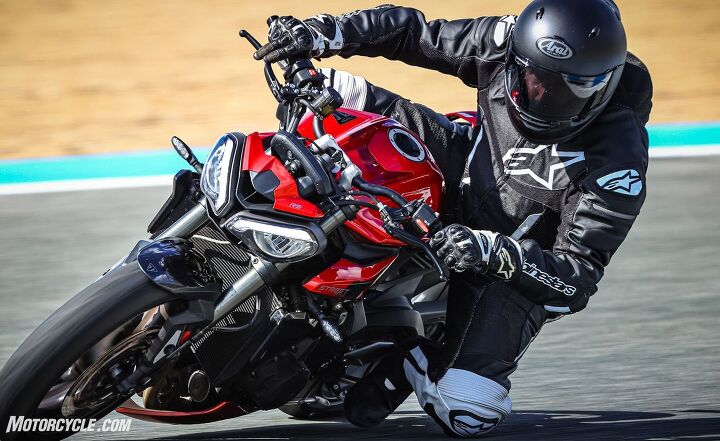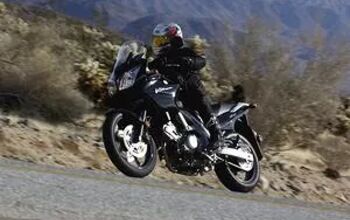MO Tested: Alpinestars Fusion 1-Piece Leather Suit Review

You say you want some ventilation?
I might as well just come out and say it: In my years as a motojournalist, I’ve had the pleasure of testing dozens of track leathers, from ill-fitting, inexpensive off-the-rack items to full-on custom-sized suits, and the Alpinestars Fusion Race Suit is the most comfortable and best breathing one I’ve ever had the pleasure of donning. Since that’s my opinion, I figured I shouldn’t string you readers out. However, if you want to find out why I feel this way, I’d be happy to tell you.
Alpinestars Fusion 1-Piece Leather Suit
The unique construction of the Alpinestars Fusion Race Suit allows it to fit both comfortably and snuggly while providing excellent ventilation.
Editor's Score: 92.5%
Comfort/Fit | 9.5/10 | Value | 8.75/10 | Innovation | 9.5/10 |
Protection | 9.5/10 | Aesthetics | 9.25/10 | Weight | 9/10 |
Construction | 9.25/10 | Options | 8.5/10 | Weather Sutability | 9.25/10 |
Desirability | 10/10 | ||||
Highs
- The torso adapts to my body shape on the bike
- Most excellent ventilation through the MATRYX structural panels on the torso
- Accommodates the Alpinestars Tech-Air 5 and 10
Sighs
- Precurved construction not ideal for walking around – so get on your bike and ride!
- Too much airflow on cool days!
- No Tech-Air 10 compatibility [Correction: It is!]
Construction Counts
As with all quality race suits, the rider’s extremities are covered with what Alpinestars calls “racing grade leather.” The impact points of the elbows, knees, and shoulders feature GP-R internal armor to absorb impacts, while the exterior DFS armor helps spread out impacts and promote sliding thanks to its hard, plastic construction. The precurved construction of the suit means that it fits best when on the bike and in a racing tuck. Just hanging in the closet the curve of the arms and legs is pronounced, but when standing in the suit off the bike, the rider is instantly aware of the curved construction of the torso. If you try to stand upright, the suit binds in the neck and crotch, but as it was designed to do, the moment you curve your body into the riding position, the Fusion suit feels completely natural.
A huge portion of the Fusion’s fit is thanks to the use of Alpinestars’ proprietary RIDEKNIT fabric throughout the crotch, rear of the leg, abdomen, chest, neck, arm holes, inner arms, and shoulder blades. This stretchy fabric, when combined with Alpinestars’ MATRYX structural panels, is responsible for the excellent breathability of the suit. In fact, if you unzip the suit’s inner liner, you can see through the MATRYX panels, like you might with a mesh jacket – that’s how it flows air so well.
So, you have the stretchability of the RIDEKNIT, which allows for a comfortably-snug fit on the rider’s body (even those of us suffering from a bit of middle-aged spread), and it combines with the flexible-but-not-stretchable MATRYX across the chest and stomach to create a custom-like fit. It’s really quite remarkable. The result is a fit that follows the curves of my torso, while providing so much ventilation that I considered wearing a windbreaker inside my suit on one cold morning. (Troy says that he sometimes wears a chest protector for this reason.)
Accommodating Protection
In addition to the built-in armor on the corners of your appendages, the Fusion suit has Bio-Flex Race hip armor to soften impacts. Additionally, there are mounts for one of Alpinestars’ Nucleon Back Protectors, if you choose one over a Tech-Air 5 airbag. The Fusion fits over the Tech-Air 5 System like it was made for it – because it was. However, the Tech-Air 5 must be placed inside the suit before you slide your arms into the sleeves of both it and the suit. Otherwise, like with any other suit, the TA5 tends to ride up your back. Once you’re in the pair, they become one and essentially disappear. Because of the unique lower-body requirements of the Tech-Air 10 - needing space around the hips for its airbag deployment - the Fusion is not compatible with the system. [Correction: Although Alpinestars does not list TA10 compatibility on the Fusion product page, I have been informed that it is fully compatible.]
On the Track
In my 30+ years of track riding, I’ve seen tremendous changes in the protection that race suits provide – and the comfort and durability they deliver while doing so. My first suit took a couple of race weekends of sweat in 90-100°F weather before it felt broken in, and it never delivered the ventilation I craved. The Alpinestars Fusion, thanks to its performance textile features, felt broken in after just a couple of track sessions, making it much easier to move around and hang off the bike. (My muscles didn’t feel like they were having to fight against the stiffness of the gear, as I have with other suits.) The ventilation was akin to that of a mesh jacket that offers significantly less protection. This improved breathability helps to counteract the restricted airflow of the Tech-Air 5, rounding out to a nice improvement in on-track cooling.
What I said at the beginning of this review still stands: the Alpinestars Fusion Race Suit is the most comfortable and best breathing one I’ve ever owned. The benefits are numerous, and the shortcomings are few. At a retail price of $1,660, the Fusion is one of the more expensive suits I’ve owned, but its breathability, fit, protection, and Tech-Air 5 compatibility make it worth the expense. Really. Try one on and find out.
FAQ
Are motorcycle leathers worth it?
If you are planning to take your bike on the track, not only are motorcycle leathers worth it, but they are also likely to be required. For the speeds and forces generated when performance riding, full leathers offer the best protection against abrasion and impact – particularly when paired with an airbag. What separates average leather suits from premium ones is the feature set, with better suits offering more venting and more supple leather without sacrificing protection.
Are motorcycle leathers too hot in the summer?
When sitting at a stop for an extended period of time, leathers can turn into a sauna, but as soon as you’re moving again, the ventilation on suits that have it, immediately turns your sweat into cooling. When you consider the heat that is generated by sliding down the pavement, a little discomfort at a stop is worth it.
Is Kevlar better than leather?
That depends. Leather offers much better abrasion resistance, which is why it is used in the high-impact and exposed areas of suits and jackets. Additionally, many track organizations require leather suits to participate in their events. However, Kevlar is often used in areas of suits that are less likely to spend extended periods sliding on the pavement. When woven with elastic materials, these technical fabric sections offer easier movement on the bike. Street gear is often made of Kevlar or similar material because the speeds tend to be lower, which lessens the abrasion requirements. Additionally, Kevlar and other textiles offer easier, more-comfortable fit in many situations.
Additional Resources
Crash Tested: Alpinestars GP Force Chaser Leather Suit
MO Tested: Dainese Racing 3 Perf. Leather Jacket And Delta 3 Perf. Leather Pants Review
MO Tested: REV'IT! Quantum One-Piece Suit Review
Correction of Tech-Air 10 added May 26, 2023.
We are committed to finding, researching, and recommending the best products. We earn commissions from purchases you make using the retail links in our product reviews. Learn more about how this works.
Become a Motorcycle.com insider. Get the latest motorcycle news first by subscribing to our newsletter here.

Like most of the best happenings in his life, Evans stumbled into his motojournalism career. While on his way to a planned life in academia, he applied for a job at a motorcycle magazine, thinking he’d get the opportunity to write some freelance articles. Instead, he was offered a full-time job in which he discovered he could actually get paid to ride other people’s motorcycles – and he’s never looked back. Over the 25 years he’s been in the motorcycle industry, Evans has written two books, 101 Sportbike Performance Projects and How to Modify Your Metric Cruiser, and has ridden just about every production motorcycle manufactured. Evans has a deep love of motorcycles and believes they are a force for good in the world.
More by Evans Brasfield
































Comments
Join the conversation